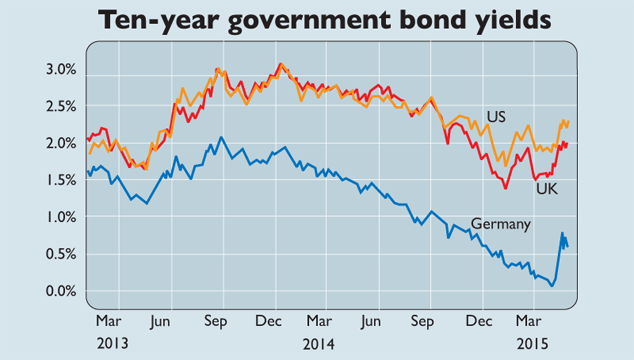
“We can all be caught up in the mood of the moment,” says Capital Economics. “But talk of a ‘rout’ in the global bond markets is, at best, premature.” The recent jump in ten-year UK, US and German bond yields – reflecting falling prices – looks “dramatic”. The German ten-year bund yield soared from 0.07% in mid-April to a high of 0.8%; this week it has fallen to around 0.6%. But the moves were smaller than 2013’s jump in yields – the so-called taper tantrum. And that was ultimately reversed.
It’s certainly too early to call the end of the bond bull market that began with the defeat of inflation in the early 1980s, agrees John Authers in the Financial Times. German yields are still lower than ever seen before December 2014. And the rise in yields may not continue.
The European Central Bank (ECB) may have convinced markets that it has done enough to avert deflation. But that’s not the same as convincing them that the recovery is entrenched, which would imply higher yields (and so lower bond prices). Bund yields “still signal deep negativity” about Europe, says Authers. And the ECB is still hoovering up bonds with printed money.
What could change the outlook? The US ultimately sets the tone for bonds. If it raises interest rates sooner than expected, or seems to be behind the inflation curve, yields could surge. But how long, as Ambrose Evans-Pritchard wonders in The Daily Telegraph, could the world economy cope with a spike in yields before it “sets off a chain of nasty consequences, and ultimately defeats itself”?
Overall debt has hit a record 175% of GDP in emerging markets and 275% in developed ones. Emerging markets have racked up $4.5trn in dollar debt. That makes economies vulnerable to dearer US money. “There comes a point when [the interest-rate rise] is too fast and too vicious, and starts to hit earnings. That is when we could get an equity sell-off,” says Andrew Roberts of RBS.
Corporate debt looks just as overpriced and as precarious as equities, whose boom “is already long in the tooth and reliant on record margin debt”, says Evans-Pritchard. Turbulence would send investors back to bonds, and may even mean more quantitative easing. Yields would fall again. So while it’s perfectly possible that we’ve seen the absolute peak of the multi-decade bond bull market, “don’t bank on it”.